Welcome to our comprehensive guide on dog muzzles designed specifically for addressing excessive barking. In this article, we’ll discuss about “Dog Muzzle For Barking”. Other subtopics we shall discuss are; Understanding Dog Barking Behavior, Types Of Dog Muzzles, Choosing The Right Muzzle For Your Dog, How To Introduce A Muzzle To Your Dog, etc.
Whether you’re a pet owner seeking solutions for your dog’s vocal habits or a trainer looking for effective tools, this guide will navigate you through the world of dog muzzles and their role in curbing barking behavior. Let’s embark on a journey toward a quieter and more harmonious relationship with your furry friend.
See Also: List of Dog Safe Flowers
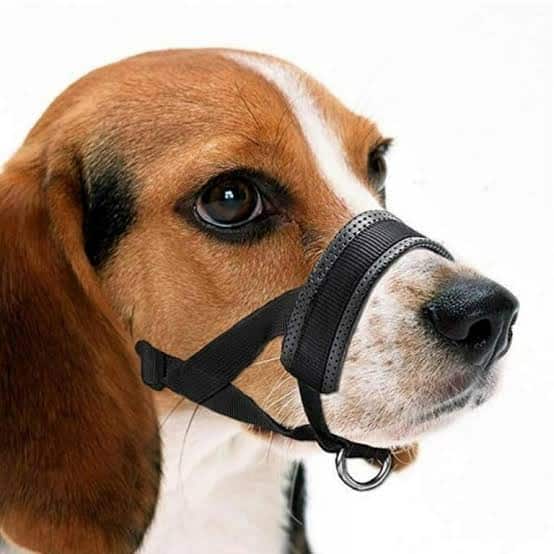
Understanding Dog Barking Behavior
Dogs communicate with us and the world around them through various vocalizations, and barking is a primary means of expression. To truly connect with our furry friends and address their needs, it’s crucial to delve into the intricacies of dog barking behavior.
Barking is innate to dogs and serves as a versatile form of communication. Understanding the nuances of their barks can help us respond appropriately to their needs. From alerting to potential dangers to expressing excitement or anxiety, dogs use barking to convey a spectrum of emotions.
While barking is natural, excessive barking may indicate underlying issues. Common reasons include:
- Loneliness or Boredom: Dogs may bark excessively when left alone for extended periods.
- Territorial Behavior: Protecting their space is instinctive, leading to barking at perceived intruders.
- Fear or Anxiety: Dogs may bark when anxious or frightened, expressing discomfort.
- Attention-Seeking: Seeking attention from owners or responding to other stimuli in the environment.
Impact On Owners And Neighbors
Excessive barking can pose challenges for dog owners and their neighbors. It may lead to strained relationships, noise complaints, and, in some cases, legal issues. Recognizing the impact of barking on the community is essential for fostering positive relationships.
See Also: Brown and White Dog Breeds
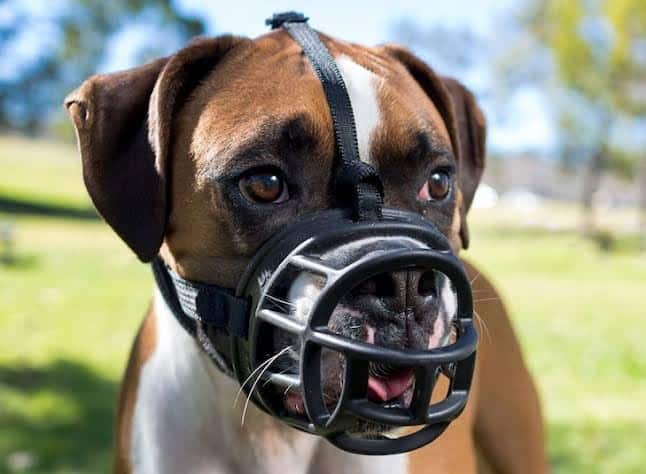
Types Of Dog Muzzles
Dog muzzles come in various shapes and sizes, each designed to cater to specific needs and situations. In this extensive guide, we’ll explore the different types of dog muzzles available in the market, providing insights into their designs, purposes, and the scenarios in which they prove most effective.
Basket Muzzles
Basket muzzles are characterized by their open, basket-like design. They allow a dog to breathe comfortably, pant, and even take treats. Ideal for walks and vet visits, basket muzzles provide effective restraint without compromising the dog’s well-being. They come in various materials, including plastic, rubber, and metal, catering to different preferences and needs.
Soft Fabric Muzzles
Soft fabric muzzles, often made from nylon or mesh, provide a gentle and comfortable restriction. While not suitable for long-term use, they serve well in situations like grooming or brief vet visits. These muzzles prioritize comfort and are often adjustable to accommodate different dog sizes.
Leather Muzzles
This is known for their durability and classic appearance. Also, the leather muzzles offer a robust solution for larger or more powerful breeds. Leather provides a sturdy yet comfortable fit, making these muzzles suitable for extended use during walks or training sessions.
Plastic Muzzles
Plastic muzzles are lightweight and practical, making them suitable for various situations. They are often used in grooming or medical settings where a quick, secure restraint is required. Plastic muzzles are easy to clean, making them a convenient choice for dog owners.
Sleeve Muzzles
Sleeve muzzles, commonly used in police or military settings, offer specialized protection for working dogs. These muzzles cover the dog’s entire snout and provide an extra layer of safety, preventing accidental bites during demanding tasks. They are crafted from durable materials to withstand rigorous use.
See Also: Bark Collars for Small Dogs
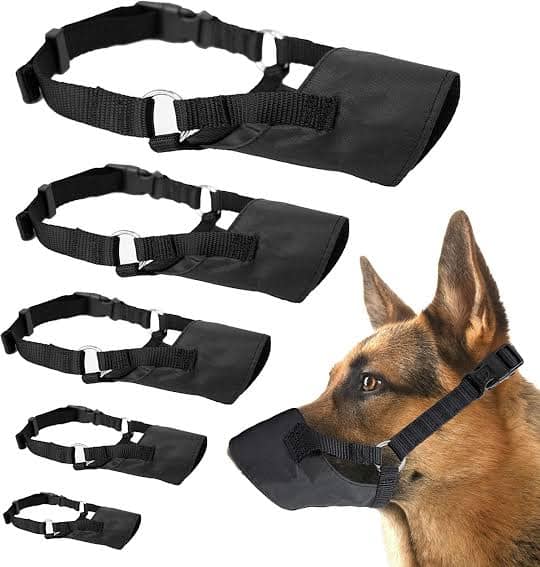
Choosing The Right Muzzle For Your Dog
Selecting the appropriate muzzle involves considering factors such as the dog’s breed, size, and intended use. Ensuring a proper fit is crucial for both effectiveness and the dog’s comfort. It’s advisable to consult with a veterinarian or professional trainer to determine the most suitable option for individual cases.
Benefits Of Using A Dog Muzzle
Dog muzzles often carry a misconception of being restrictive or negative. However, when used responsibly, muzzles can provide a range of benefits, ensuring the safety and well-being of both dogs and those around them. Below are some of the benefits of using a Dog Muzzle.
I. Preventing Bites and Aggressive Behavior
One of the primary benefits of a dog muzzle is its ability to prevent bites and control aggressive behavior. Whether during vet visits, grooming sessions, or encounters with unfamiliar people or animals, a properly fitted muzzle ensures that the dog cannot inflict harm, providing a layer of safety for everyone involved.
II. Safe Socialization and Training
Muzzles are valuable tools for socializing and training dogs. They allow controlled interactions with other dogs and people, minimizing the risk of aggressive behavior. This controlled exposure aids in desensitization and positive reinforcement, contributing to a well-behaved and socially adapted canine companion.
III. Reducing Stress and Anxiety
For dogs that experience stress or anxiety in specific situations, such as crowded places or noisy environments, muzzles can provide a sense of security. By preventing unwanted interactions or behaviors, muzzles create a controlled space, alleviating stress and promoting a more relaxed state of mind for the dog.
IV. Preventing Inappropriate Chewing and Eating
Dogs may exhibit inappropriate chewing or eating behaviors, putting them at risk of ingesting harmful substances. Muzzles act as a preventive measure, restricting the dog’s ability to chew on potentially toxic items during walks or outdoor activities, promoting their overall safety.
V. Injury Prevention During Medical Procedures
During medical examinations or treatments that may cause discomfort, dogs may react defensively. Muzzles are essential in these situations, preventing unintended bites and ensuring the safety of both the dog and the veterinary staff. This promotes a smoother and less stressful experience for everyone involved.
VI. Complying with Legal Requirements
In some regions, specific dog breeds or dogs with a history of aggression may be required to wear muzzles in public spaces. Complying with such legal requirements ensures a safe environment for all community members and helps avoid potential legal issues for dog owners.
See Also: 5 Best Nail Scratch Pad for Dogs
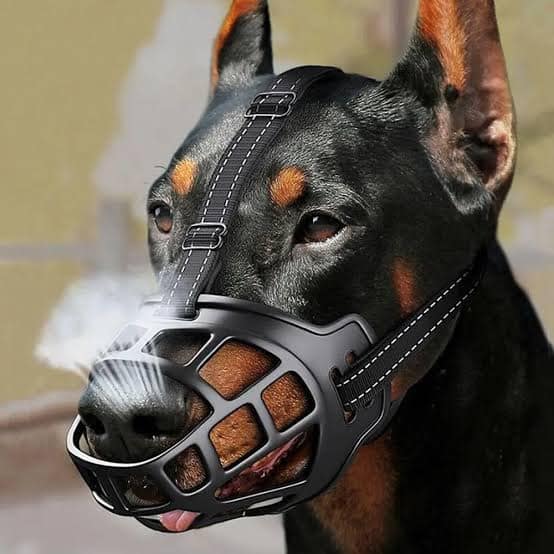
How To Introduce A Muzzle To Your Dog
Introducing a muzzle to your dog may seem like a daunting task, but with patience, positive reinforcement, and a gradual approach, it can be a stress-free experience for both you and your furry friend. Below are the steps to ensure a smooth introduction of a muzzle to your dog.
I. Choose the Right Muzzle
Selecting an appropriate muzzle is the first crucial step. Ensure it is the correct size and type for your dog’s breed and comfort. Opt for a well-fitting muzzle that allows your dog to pant and receive treats.
II. Familiarize Your Dog with the Muzzle
Before attempting to put the muzzle on, let your dog explore and sniff it. Allow them to become familiar with the muzzle’s presence, associating it with positive experiences by offering treats and praise.
III. Positive Reinforcement
Create a positive association by rewarding your dog when they show interest in or approach the muzzle. Offer treats and praise to reinforce the idea that the muzzle is not a threat but rather a positive and rewarding accessory.
IV. Touch Training
Gradually introduce touching around your dog’s snout, simulating the sensation of the muzzle. Use your fingers or a soft cloth to gently touch the areas where the muzzle will rest. Continue rewarding positive reactions with treats and encouragement.
V. Short Wear Sessions
Start with short sessions of having the muzzle on your dog. Initially, only secure the muzzle for a few seconds, gradually increasing the duration as your dog becomes more comfortable. Use treats and verbal praise to reward calm behavior.
VI. Incorporate Treats Through the Muzzle
Encourage your dog to put their nose through the muzzle by placing treats inside. This not only makes the experience positive but also helps your dog associate the muzzle with a rewarding activity.
VII. Practice and Patience
Consistency is key. Practice the muzzle introduction in various environments and situations to ensure your dog is comfortable in different settings. Be patient and progress at your dog’s pace, allowing breaks if needed.
VIII. Observe Body Language
Pay close attention to your dog’s body language during the process. If they show signs of stress or discomfort, take a step back and reassess. It’s essential to proceed at a pace that suits your dog’s individual temperament.
IX. Gradual Exposure to Straps
Once your dog is comfortable with the muzzle around their snout, gradually introduce securing the straps. Always reward positive behavior and take it slow, ensuring your dog remains calm and relaxed.
X. Use During Positive Activities
Associate the muzzle with enjoyable activities, such as going for walks or playtime. This reinforces the idea that wearing the muzzle leads to positive experiences, making your dog more accepting of its use.
XI. Seek Professional Guidance if Needed
If you encounter challenges or if your dog displays persistent anxiety, consider seeking guidance from a professional dog trainer or behaviorist. They can provide tailored advice based on your dog’s unique needs and temperament.
See Also: Senior Dogs Arthritis Exercises
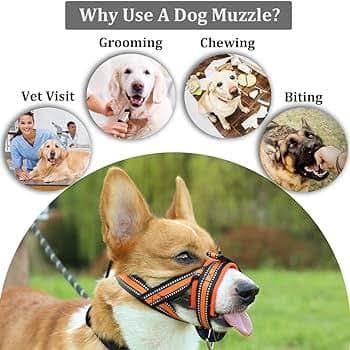
Safety Considerations For Using Muzzles On Dogs
While dog muzzles can be valuable tools, ensuring their safe and responsible use is paramount. Understanding the safety considerations associated with muzzles helps prevent potential issues and ensures the well-being and comfort of both the dog and its owner.
The essential safety considerations when using muzzles on dogs are:
I. Choose the Right Size and Type
Selecting the correct size and type of muzzle is the foundation of safe usage. A well-fitted muzzle allows the dog to pant, drink water, and feel comfortable. Consider the breed, size, and purpose when choosing a muzzle, ensuring it meets both safety and functionality requirements.
II. Gradual Introduction and Positive Association
Introduce the muzzle to your dog gradually, associating it with positive experiences. This process builds a positive association, making your dog more accepting of the muzzle. Use treats, praise, and patience to create a stress-free introduction.
III. Monitor Breathing and Overheating
Ensure that the chosen muzzle allows your dog to breathe comfortably. Monitor their breathing during use, especially in warm weather, to prevent overheating. Avoid extended use in hot conditions, and always provide ample opportunities for your dog to drink water.
IV. Avoid Prolonged Use
Muzzles are designed for temporary use, not for extended periods. Avoid leaving the muzzle on for an extended duration, as this can lead to discomfort, stress, or potential breathing difficulties. Use the muzzle for its intended purpose and remove it when no longer necessary.
V. Regular Checks and Adjustments
Regularly check the fit of the muzzle to ensure it remains secure and comfortable. Dogs may attempt to remove or adjust the muzzle, and any signs of discomfort or misalignment should be promptly addressed. Periodically assess the condition of the muzzle for wear and tear, replacing it if necessary.
VI. Acclimate to Different Environments
Gradually acclimate your dog to wearing the muzzle in various environments. This helps them feel comfortable and confident in different situations. Introduce the muzzle during walks, visits to the vet, or other scenarios where its use may be necessary.
VII. Professional Guidance for Behavioral Concerns
If your dog exhibits behavioral issues or discomfort with the muzzle, seek professional guidance from a dog trainer or behaviorist. They can provide tailored advice and techniques to address specific concerns, ensuring a positive and stress-free experience for your dog.
VIII. Ensure Visibility and Identification
If using a muzzle in public spaces, ensure it doesn’t obstruct your dog’s vision and that they remain easily identifiable. This is especially important for preventing unnecessary fear or panic in others who may encounter your muzzled dog.
IX. Educate Others and Address Misconceptions
Educate those around you about the purpose of the muzzle and its positive role in ensuring safety. Address any misconceptions or concerns people may have, fostering a better understanding of responsible muzzle usage.
X. Regular Training and Reinforcement
Incorporate regular training sessions to reinforce positive behavior and acceptance of the muzzle. This ongoing training enhances the effectiveness of the muzzle and promotes a cooperative relationship between you and your dog.
See Also: Dog Car Bed: Why you need a Good Dog Car Bed
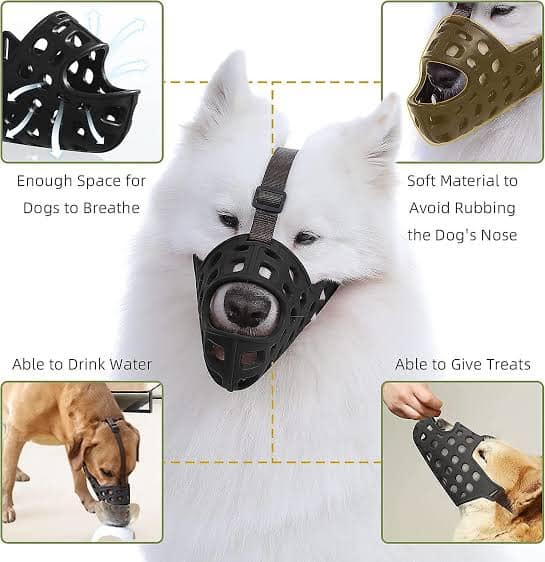
Myths And Misconceptions About Dog Muzzles
Dog muzzles often carry misconceptions that can contribute to misunderstandings about their purpose and use. In this in-depth exploration, we’ll debunk prevalent myths and clarify misconceptions surrounding dog muzzles. We shall shed light on their true nature and the positive roles they can play when used responsibly.
I. Myth: Muzzles Are Only for Aggressive Dogs
Reality: While muzzles are commonly associated with aggressive behavior, they serve various purposes beyond aggression management. Muzzles can be beneficial for preventing biting during medical procedures, grooming, or in situations where a dog may feel anxious or stressed.
II. Myth: Muzzles Cause Discomfort and Stress
Reality: When introduced gradually and used appropriately, muzzles can be comfortable for dogs. Positive reinforcement during the introduction process helps create a positive association, reducing stress. Dogs can adapt well to wearing muzzles with proper training and acclimatization.
III. Myth: Muzzles Inhibit Dogs’ Natural Behaviors
Reality: Muzzles are designed to allow dogs to breathe, pant, and even take treats when properly fitted. They should not hinder natural behaviors significantly. Muzzles can provide a controlled environment for training and socialization, promoting positive behavior.
IV. Myth: Only ‘Bad’ Dogs Need Muzzles
Reality: All dogs, regardless of their behavior, may benefit from wearing a muzzle in certain situations. Whether it’s for a vet visit, grooming, or preventing scavenging during walks, muzzles can be a useful tool for responsible dog owners.
V. Myth: Muzzles Make Dogs More Aggressive
Reality: When used responsibly, muzzles do not make dogs more aggressive. In fact, they can prevent aggressive behavior by avoiding situations that trigger aggression. Muzzles provide a safety measure, especially during unfamiliar or potentially stressful situations.
VI. Myth: Muzzles Are a Last Resort for ‘Problem’ Dogs
Reality: Muzzles can be introduced preventively as part of responsible dog ownership. Using them proactively in training and socialization efforts can help prevent behavioral issues from escalating. They are not solely reserved for dogs with existing problems.
VII. Myth: Muzzles Are Cruel and Inhumane
Reality: Muzzles, when introduced and used correctly, are not cruel. They are designed to ensure the safety of both dogs and those around them. Responsible usage, positive reinforcement, and regular training sessions make muzzles a humane and effective tool.
VIII. Myth: Muzzles Are One-Size-Fits-All
Reality: Muzzles come in various sizes and types, catering to different breeds and purposes. It’s crucial to choose the right size and type for your dog, ensuring a proper fit and comfort. Ill-fitting muzzles can cause discomfort and may not serve their intended purpose.
IX. Myth: Muzzles Are a Sign of a ‘Bad’ Owner
Reality: Using a muzzle responsibly is a sign of a responsible and caring dog owner. It demonstrates a commitment to the safety of both the dog and the community. Muzzles are tools that, when employed appropriately, contribute to responsible dog ownership.
See Also: Senior Dog Supplements

Frequently Asked Questions
Why Would I Use A Muzzle For My Dog’s Barking?
Dog muzzles for barking can be used as a training tool to manage excessive barking. They help redirect and modify the behavior while providing a temporary solution during training.
Are Muzzles Effective In Stopping Barking Completely?
While muzzles can help manage and reduce barking, they are not a guaranteed method for stopping it altogether. Training, positive reinforcement, and understanding the root cause of the barking are essential components of a comprehensive approach.
Will Using A Muzzle Harm My Dog Or Make Them Uncomfortable?
When fitted properly and introduced gradually, muzzles should not harm or make your dog uncomfortable. Positive reinforcement during the introduction process helps create a positive association, reducing stress.
Can I Use Any Type Of Muzzle For Barking?
There are various types of muzzles, and while some are designed specifically for barking, any well-fitted muzzle can help manage excessive vocalization. Choosing the right type depends on your dog’s size, breed, and comfort.
How Do I Introduce A Muzzle To My Dog For Barking?
Introduce the muzzle gradually, associating it with positive experiences like treats and praise. Start with short wear sessions, and gradually increase the duration. Consistent positive reinforcement is key to successful introduction.
Can My Dog Eat Or Drink While Wearing A Muzzle For Barking?
Most muzzles allow dogs to drink, but eating may be restricted. Choose a design that permits panting, drinking, and, if necessary, opt for short wear sessions to allow for meal breaks.
Is It Safe To Use A Muzzle For Barking During Walks?
Yes, it can be safe to use a muzzle for barking during walks, especially if your dog tends to become overly excited or reactive. Choose a comfortable muzzle that allows your dog to pant and breathe easily.
Are Muzzles A Long-Term Solution For Barking Issues?
Muzzles are not a long-term solution for addressing the root causes of barking. They are a management tool that can be used during training to modify behavior. Identifying and addressing the reasons behind the barking is crucial for a lasting solution.
Can I Leave A Muzzle On My Dog All Day To Control Barking?
It’s not recommended to leave a muzzle on your dog for extended periods. Muzzles are designed for temporary use and should be used responsibly to prevent discomfort, stress, or potential breathing difficulties.
Conclusion
In the journey of responsible dog ownership, the use of a dog muzzle for barking emerges as a valuable tool, not just for managing vocalization but also for fostering a harmonious bond between canine companions and their owners. As we navigate the realms of canine behavior and communication, it becomes evident that a well-introduced and properly used muzzle can play a pivotal role in addressing excessive barking.
Understanding that barking is a natural form of expression for dogs, the aim is not to silence them but to channel their behavior positively. The use of a muzzle becomes a component of a broader strategy that includes training, positive reinforcement, and addressing underlying causes of barking.
Through this exploration, we’ve debunked myths, clarified misconceptions, and provided insights into the diverse types of muzzles available. It’s crucial to approach the use of a muzzle with patience, positive reinforcement, and a commitment to understanding your dog’s unique needs.
